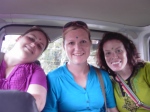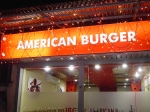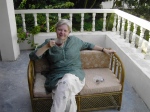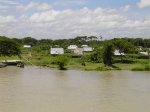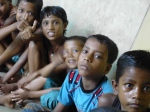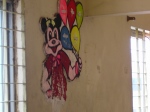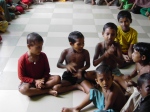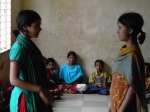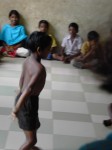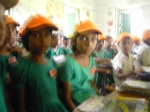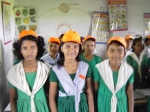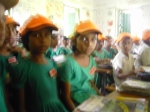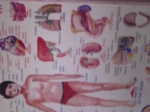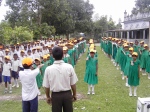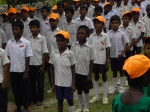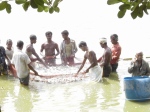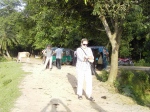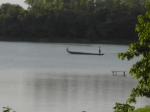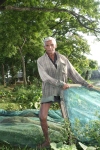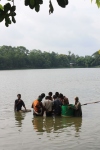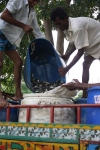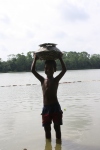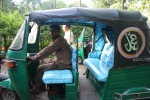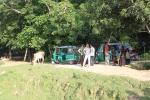This is an excerpt from a case study that my group is working on. It is long but I think it gives a good example of the life of a Grameen borrower.
Jihada has no idea how old she is but she assured us that her seven-year-old daughter Mitu will go to the University one day. This is the difference between a family that has money and a family that does not, a family that values daughters and one that does not. All of this is because of Grameen Bank. Not only has the bank given Jihada’s family an opportunity to create and grow a business but it has started a movement that has changed the very culture of the Bangadeshi poor in how women are valued.
The lines on Jihada’s face tell a story of hardship as she sits in her home that is large enough for two beds and a couch. The floor has a beautiful round inset in the treated concrete floor and the ceiling is a colored thatch ceiling covered by tin. The ceiling has large blocks of color in green, red and yellow. The walls are tin. This is more than an adequate home in the village and we guess that she would be considered middle class. The beds and couch are a beautiful hand carved light wood and she has fabric-covered pillows on the seat and back of the couch for us to sit on. Jihada’s life before this home doesn’t seem to fit with the life she has now. She looks almost 40 but because her oldest child is seven, we guess that she is just older than thirty. She also has a younger son.
Her husband is off at their fisherie business where they employ people to help with the work. He runs the business while she takes care of the home which is different than what we expected. In the early days of Grameen, women were chosen to receive the loans and start the business but that was years ago and today while women receive the loans the men often work the businesses. The family is still elevated as the mother and father work as a team. It is the woman that continues the relationship with Grameen and attends Center meetings. We learned that this is pretty typical for the village.
The family has been borrowing from Grameen for almost 17 years. Jihada belongs to the Kuthi Center which has 60 members. This means that there are 12 groups of five. Five women must form a group before they can receive their loans. They each receive a loan and their businesses can be diverse but they are connected in that they support each other in determining business decisions and if one of them defaults on a loan they all default. This increases the repayment rate. Kuthi is part of the Sirajgonj Grameen Bank Branch which has had perfect repayment in June and July. The Kuthi Center was started in 1985 and most of the loans are for farming businesses including rice, jute and vegetables.
Three of the women have children who have taken education loans to pay for the University. The largest loan in this Center is 70,000 taka which was used for a cow business. We have learned that this is one of the most lucrative businesses. A woman can buy two cows for 17,000 taka, feed them for six months for 10,000 taka then sell them at the end of the six months for 50,000 taka which is almost double the original investment. The largest special investment loan is for 100,000 taka.
Four of the women have taken housing loans but they have been repaid and most purchase homes from their earnings rather than borrow again. A few have taken loans for creating sanitary latrines (squat toilets which we learned to use in the village with success). The women do not like to take housing loans because these loans are long-term loans and they prefer to take loans that can be paid off in one year.
This is the case for Jihada’s family who built their home from their income. When she joined Grameen, her husband was very supportive. She had heard about Grameen from other villagers and the bank had become very respected and well-known by 1995. This was not the case in the beginning.
The area manager, who is over eight bank branches, told us he started with Grameen in 1991 as an assistant manager (called an associate manager) when Grameen was not well-known. He said that there were many rumors about Grameen and that the men were against the bank that helped women. Rumors included that the bank would convert the women from Islam. His favorite memory of this time was trying to start a Center in a small village. A woman came to the Center meeting very upset because her in-laws were in town and were angry that she had joined the bank. As the assistant manager, he wanted to go talk to the family and explain that they would not try to convert her from being Muslim. She begged them not to come to the home but they went anyway, determined to change the minds of the in-laws and many of the other villagers.
They tried to explain to the in-laws but they would not believe them. In fact, many of the villagers were also against the bank so much that they were not able to establish the Center at that time. A few years later, he went back to visit that area of the village where the Center had finally been created. When he got there, he learned that the in-laws had become Grameen members and opened a prosperous farming business as a result.
Today, according to Jihada and others, this is not the case. She and her husband were eager to join Grameen. Before joining Grameen, the family lived in a small thatch home. They had a small rice business that barely made enough money to feed them each month. Jihada borrowed 4,000 taka to improve their rice business. With this money, there were able to increase their business and they continued in this way for 11 years, gradually increasing their Grameen Personal Savings Account until they could afford their new home. Her husband worked the rice business while she maintained the relationship with Grameen and the home.
When Jihada became pregnant in the tenth year of the business, she and her husband wanted to make more money to pay for their growing family. They had dreams of their child—whether the child was a boy or girl—of growing up healthy, attending school and going off to University. They knew they needed more money to give their child the life that they dreamed about. This is a change from Jihada’s family where they didn’t record her age. This is typical of earlier life in the village. An official at Grameen told us that when they first started working with the women, some did not even know what their names were.
When Mitu was born, they decided to start a more lucrative fish business. With their savings and a 50,000 taka loan, the family purchased a small pond that her husband began to fish. To fish, a large net is placed in the pond and a team of people work the net up and in to collect the fish in barrels. From this business, they employ three people and make 10,000 to 15,000 taka each month. They have already paid off their loan in one year but Jihada continues to attend the Center meeting with her group of five to discuss business and socialize. They have plans to expand their fish business and employ more people with the money they make each month. They understand the importance of investing to continue their prosperity.
Jihada smiles at Mitu when she says that if needed, Mitu will apply for a higher education loan when it is time to go to the University but she and her husband hope they will have enough money saved to pay for Mitu’s continued education. This is a lot of hope for a seven year old who attend Banbaria Government Primary School where four teachers guide 304 first through fifth graders through their studies. Mitu is lucky here because her family can afford the uniforms required to attend the school. The teachers tell us that 60% of the students cannot afford uniforms. A collection is taken from the villagers and foreigners to create a trust to pay for the uniforms as well as a trust created to help children who are not part of Grameen families go to higher education when ready.

